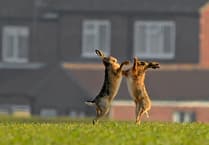How do you keep cattle fenced in without a fence? That’s what Surrey Wildlife Trust is achieving, using an ingenious new “no-fence” technology which ensures its cattle used for conservation grazing stay within set areas.
From spring until autumn, SWT and other members of the farming community use carefully-managed herds of cattle and sheep to maintain sites in a way that works for nature. It’s called conservation grazing. The animals graze on scrub, the collective term for a range of woody vegetation such as young trees, shrubs and garden escapees such as rhododendron and pyracantha.
Controlling scrub is important, otherwise it tends to suppress more delicate flora and constrains biodiversity. Fewer plant species results in fewer invertebrates, birds and other animals.
Groups of grazing animals are moved between commons, and from place to place across large sites, so many nature habitats can benefit from their grazing over the course of the year. You may have seen some of SWT’s herd of Belted Galloway cattle grazing on our local commons.
Now the clever bit. No-fence grazing uses a mobile phone app, on which the grazing manager can set a grazing area. Each animal carries a special GPS collar and they all communicate over a mobile phone network. Each collar detects its exact position and sounds a warning to the animal if it approaches the boundary. If the animal ventures to the boundary, the collar delivers a harmless mild electric pulse, just enough to be uncomfortable. The animal soon learns to turn back as soon as it hears the warning sound, so avoiding the unpleasant experience.
No-fence is one of the reasons Surrey Wildlife Trust launched an urgent £50,000 appeal last autumn, so it can extend its conservation grazing and keep Surrey’s meadows, woodlands and heathlands buzzing with life as the climate and nature crisis bites.
In launching the appeal SWT said that with increases in costs for overwintering, feed and veterinary care, additional funding is urgently needed to maintain the SWT’s herds of 250 Belted Galloway cattle and 70 sheep, and to expand conservation grazing to other areas across Surrey. By extending the use of no-fence grazing, the trust saves money because costly fencing is unnecessary and it also enables more targeted grazing. It also means herds can be moved to new grazing territory safely, quickly and easily.
Electric fencing is still used in locations where no-fence grazing isn’t currently viable.
The £50,000 target has been reached, and SWT Marketing Officer Carly Potter commented: “We've been taken aback by the strength of support for this fundraising effort.
“It’s heartening that, even in difficult times, people still care enough about our natural environment to make a contribution.”
Carly said that any further contributions to the trust and its fundraising appeals are still greatly needed and valued, given the scale of the task the grazing team faces to protect and preserve nature in the current climate and biodiversity crisis.
The trust is justifiably proud of its Belted Galloway cattle and has its own superstar, Wisley Earthworm, who was crowned breed and interbreed champion at the Melton Mowbray Rare and Native Breed Show last September.

SWT farm and livestock manager James Stoyles said: “Years of selective breeding, genetics and training have created a healthy and robust herd that makes the maximum impact for nature and helps raise awareness of what well-managed grazing can achieve for wildlife habitats.”
By Royer Slater





Comments
This article has no comments yet. Be the first to leave a comment.